- Meet our representative at your arrival at Hosea Kutako International Airport [WDH], Windhoek
- Road transfer to your hotel in Windhoek
Stay at Am Weinberg Estate’s Boutique Hotel in a Courtyard-view Room, for 1 night



- Dinner: we recommend Joe's Beerhouse
Inspired by the fascinating character of Namibia and its people, Joe's is where a love for adventure, stories, and living to the fullest, comes to vibrant life. Through our unique combination of delicious and authentic food, heartfelt hospitality, and our one-of-its-kind atmosphere, we feed the mouth and soul, celebrate old memories; and build new ones with you
So much more than just another restaurant. For people who still dream of a truly great escape.
Wine Lounge
SPA at Am Weinberg Estate’s
- Bed & Breakfast service
- Laundry service
- Lunch & Dinner
- SPA at Am Weinberg Estate’s
- Excursions and activities in Windhoek
- After breakfast, you will be met at the reception by one of our staff members
- Road transfer to [ERS] Eros Airport, where you will receive a warm greeting by your pilot.
- Scheduled shared charter flight from [ERS] to Wolwedans airstrip
- Road transfer from the airstrip to your lodge
- Stay at Wolwedans Dunes Camp in a Deluxe tent, for 2 nights
- Enjoy the lodge activities



The NamibRand Nature Reserve, located in southern Namibia, is a private nature reserve established to help protect and conserve the unique ecology and wildlife of the south-west Namib Desert. Conserving the pro-Namib, the area along the eastern edge of the Namib Desert, is critically important in order to facilitate seasonal migratory wildlife routes and to protect biodiversity. It is probably the largest private nature reserve in southern Africa, extending over an area of 215,000 ha. The Reserve shares a 100km border with the Namib-Naukluft National Park in the west and is bordered in the east by the imposing Nubib Mountains. Virtually all facets of the Namib Desert are represented on the Reserve – sand and gravel plains and stretches of savanna alternate with mountain ranges, inselbergs, and vegetated dune belts.
Wolwedans Hot-air Ballooning
- Fully inclusive: Bed, all Meals, Fees, and Activities
- Hot-air Ballooning
- After a delicious breakfast, road transfer to Wolwedans airstrip
- Scheduled shared charter flight to Sossusvlei airstrip
- Road transfer to your lodge
- Stay at Sossusvlei Lodge, in a Superior Room for 1 night
- Once you have arrived at the lodge you can take part in the optional activities






Dune 45!
There is a reason why the dune is on the cover page of most of the books on Namibia. Dune 45 is a star dune in the Sossusvlei area of the Namib Desert in Namibia. Its name comes from the fact that it is at the 45th kilometer of the road that connects the Sesriem gate and Sossusvlei. Standing over 170 m, it is composed of 5-million-year-old sand that is detritus accumulated by the Orange River from the Kalahari Desert and then blown here. A paradise for photographers. The best sunrise you will ever experience.
The major parts of the Namib Naukluft Park are inaccessible for humans. Of the huge area of which 32,000 km² exist of dune fields only the area north of the Kuiseb River, the Naukluft Mountains and the Sossusvlei can be visited.
Deadvlei
Close to Sossusvlei, Deadvlei is a clay pan characterized by dark, dead camel thorn trees contrasted against the white pan floor. The pan was formed when the Tsauchab River flooded and the abundance of water allowed camel thorn trees to grow. However, the climate changed and the sand dunes encroached on the pan, blocking the river from reaching the area. The trees are estimated to be approximately 900 years old, however, they have not decomposed due to the dry climate.
Deadvlei is a paradise for photographers as the contrast between the pitch-black trees and bleached-white pans, and the rusty-red dunes and deep blue sky make for incredible images.
Quad Buggy Nature Trail
- Bed & Breakfast, Dinner
- Lunch
- Lodge Activities
- Hot Air Balloon Experience
- Road transfer from your lodge to Sossusvlei Airstrip
- Scheduled shared charter scenic flight over the coast of Namibia from Sossusvlei to Swakopmund Airport [SWP]
- Road transfer to your hotel
- Stay at Strand Hotel Swakopmund, in a Sea View Luxury Room for 2 nights
- Enjoy the town activities and the neighborhood


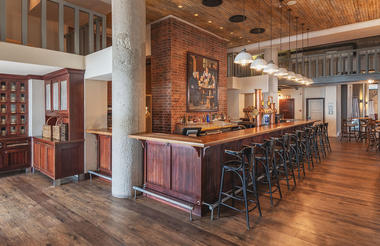

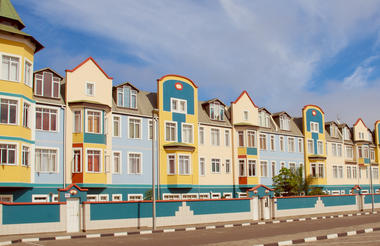
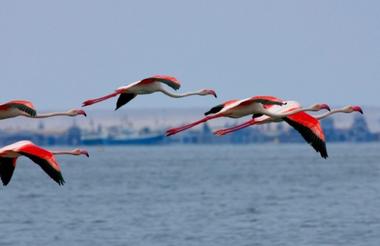
Swakopmund
It looks like being in Germany! Swakopmund, known as Swakop in Namibia, is the country’s biggest coastal town and a resort for Namibians on holiday. The city’s German origins are quite pronounced in beautiful old German colonial buildings throughout the city, making an even starker contrast for this town sitting at the edge of the Namib Desert.
Why we would like our clients to stay in Swakopmund? Beautiful dunes, a vibrant city, and above all, Sandwich Harbour.
Once you will obtain the permit (instructions will be given), you drive along a beautiful dune chain adjacent to the Atlantic Ocean, zigzagging the original railway line between Swakopmund and Walvis Bay. This is an opportunity for a detailed look at the formation of ‘the world’s oldest desert’, and the bird paradise surrounding you.
As soon as you get close to the dunes and the ocean, the dramatic landscape will capture your imagination. It will soon become clear why Sandwich Harbour is often described as inaccessible! Spring tides and shifting sands ensure an unpredictable route, but as you approach the towering, wind-sculptured dunes at the edge of Sandwich Harbour, there is a sense of entering a different world. You will drive on a thin stretch of sand between the dunes and the ocean.
A truly unique experience.
Activities at Swakopmund
Boat Trips: We highly recommend taking a boat cruise whilst in Swakopmund. You can enjoy trips up the coast to Pelican Point, the Oyster.
Farm, Bird Island, and the Lighthouse. At the right time of year (July-November) you can expect to see Bottlenose & Heaviside Dolphins, Cape Fur Seals, Penguins, Whales & Leatherback Turtles.
Quad Biking: Head out into the dunes behind Swakopmund on quad bikes that reach areas you won’t be able to get to any other way. You can choose trips that will take you out from one hour to a full morning - a fun trip for all the family.
Scenic Flights: Take a low-level flight up the Skeleton Coast to see the best views of the many shipwrecks that have made this coastline so well known. The planes are five - nine seaters and you can book seats for trips down to Sossusvlei (2 h) or up to the Skeleton Coast (2 h) and it's worth being aware that fuel prices fluctuate hugely and these trips are best booked in advance. Prices vary from 390 USD pp - 985 USD pp depending on numbers in the plane.
Kayak Trips: From Walvis Bay, you can take guided kayak trips around Pelican Point which is ideal for birders. Trips are for two hours or a full morning and are done at this time of the day due to the winds.
Cape Cross Seal Reserve
Cape Cross has both historic and biological significance and is a popular tourist attraction. The Portuguese navigator, Diego Cão, landed here in 1486 on his second expedition south of the equator and planted a stone cross (padrão) to mark his journey. A replica is visible here today. Inclusive of a second replica, the area has been listed as a National Heritage Site. In the late 1800s, thousands of tons of guano (dried excrement of fish-eating birds used as fertilizer) were collected and exported to Europe. Cape fur seals were also harvested. About 100 workers lived at Cape Cross and a police station, customs and post office were established at the settlement, while a railway (the first in the country) was built to cross the salt pan and transport workers. Many men lost their lives due to the harsh conditions at Cape Cross.
This reserve is a sanctuary for the world’s largest breeding colony of Cape fur seals, with up to 210,000 seals present during the breeding season in November and December. Sustainable seal harvesting takes place in the reserve annually under the auspices of the Ministry of Fisheries and Marine Resources, which also sets the quota of seals to be harvested.
The Skeleton Coast and its Shipwrecks
The Skeleton Coast is the northern part of the coast of Namibia, south of the Kunene River to the Swakop River. It is also often used to describe the entire Namib Desert coastline.
The Skeleton Coast is associated with shipwrecks, and stories of sailors walking through the desert in search of food and water. The name is derived from the bones that lined the beaches as a result of whaling operations and seal hunts. A few of the skeletons were human.
The blinding fog typical of this coast results in ships running aground or wrecking on the off-shore rocks. The coast is littered with scores of shipwrecks, some are barely recognizable, others are still in remarkably good condition.
The Zeila is the closest to Swakopmund. The ship stranded on 25 August 2008 in the early morning hours near "Die Walle", a popular fishing spot about 14 km south of Henties Bay. The fishing trawler that was sold as scrap metal to an Indian company by Hangana Fishing of Walvis Bay got stranded after it came loose from its towing line while on its way to Bombay, India shortly after it left Walvis Bay.
- After breakfast, road transfer to Swakopmund Airport
- Scheduled shared charter flight from Swakopmund Airport to Twyfelfontein airstrip
- Road transfer to your lodge
- Stay at Mowani Mountain Camp, in a Deluxe View Room for 2 nights


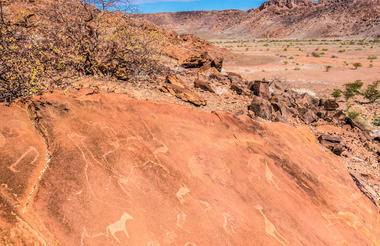
Damaraland
Remoteness! Damaraland was a name given to the north-central part of what later became Namibia, inhabited by the Damaras. It was bounded roughly by Ovamboland in the north, the Namib Desert in the west, the Kalahari Desert in the east, and Windhoek in the south.
During the Namibian summer (November-March) the Damaraland experiences very high temperatures of up to 40°C. The annual rainfall is low, some year it is completely absent. Numerous large dry river beds meander, which after heavy rainfall turn into torrential rivers within hours.
The flora and fauna of the region have adapted perfectly to the harsh weather conditions of high heat and persistent droughts. Here you find the desert-dwelling elephants who with elongated limbs and broader soles are able to handle the extreme rock and sand desert better and can travel for miles in the dry river beds in search of water. Also, the critically endangered desert lions managed to adapt to the arid climate. Numerous endemic desert plants are found in Damaraland such as the poisonous but photogenic Euphorbia Virosa and the ancient Welwitschia Mirabilis.
Twyfelfontein
The site of Twyfelfontein site is included in the UNESCO World Heritage List. It forms a coherent, extensive and high-quality record of ritual practices relating to hunter-gatherer communities in this part of southern Africa over at least 2,000 years, and eloquently illustrates the links between the ritual and economic practices of hunter-gatherers.
Twyfelfontein boasts one of the most extensive collections of rock art in Africa with over 2,500 examples scattered around the local area. The engravings are about 6,000 years old and were most likely made by San hunters during the Early Stone Age. The images (which are dominated by animals and animal tracks) were created by cutting into the soft stratum that coats the local sandstone. When the rocks subsequently eroded, this stratum was regenerated, hence covering the original engravings and preserving them for thousands of years. Not far from Twyfelfontein is a distinctive, volcanic ridge and the unusual Burnt Mountain, which looks exactly as its name suggests; as if someone has set fire to a mountain and all that is left is a pile of ashes and clinker.
- Full Board: Dinner, Bed, Breakfast, Lunch
- In the morning, road transfer from the lodge to Twyfelfontein airstrip
- Scheduled shared charter flight to Ongava airstrip
- Road transfer to your lodge
- Stay at Little Ongava, in a Standard Suite Room for 2 nights

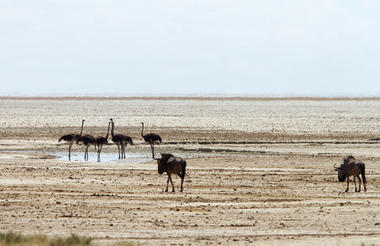

Etosha National Park
What makes the Etosha unique are the waterholes and the concentration of wildlife around them. Etosha park is any photographers dream. Plan your visit to Namibia and experience the great white area of Etosha.
Etosha Game Park was declared a National Park in 1907 and covering an area of 22,270 square km, it is home to 114 mammal species, 340 bird species, 110 reptile species, 16 amphibian species and, surprisingly, one species of fish. Etosha Park is one of the first places on any itinerary designed for a holiday in Namibia.
Etosha, meaning “Great White Place”, is dominated by a massive mineral pan. The pan is part of the Kalahari Basin, the floor of which was formed around 1000 million years ago. The Etosha Pan covers around 25% of the National Park. The pan was originally a lake fed by the Kunene River. However, the course of the river changed thousands of years ago and the lake dried up. The pan now is a large dusty depression of salt and dusty clay which fills only if the rains are heavy and even then only holds water for a short time. This temporary water in the Etosha Pan attracts thousands of wading birds including impressive flocks of flamingos. The perennial springs along the edges of the Etosha Pan draw large concentrations of wildlife and birds.
The game viewing in Etosha National Park is excellent, the best time being from May to September – the cooler months in Namibia. Visitors to Etosha Game Reserve can expect to see many buck species, elephant, giraffe, rhino, and lions. More fortunate visitors will see leopard and cheetah. There is a network of roads linking the five camps and subsidiary roads lead to various waterholes.
- Fully inclusive: Bed, all Meals, Fees, and Activities
- Excursions into Eastern Etosha National Park
- After breakfast, road transfer to Ongava Airstrip
- Scheduled shared scenic charter flight on the Etosha National Park to Onguma Airstrip
- Road transfer to your lodge
- Stay at Onguma The Fort, in a Bush Suite for one night



Enjoy the lodge activities, and explore another corner of the Etosha National Park.
- Fully inclusive: Bed, all Meals, Fees, and Activities
- Excursions into Western Etosha National Park
- After breakfast, road transfer to Onguma Airstrip
- Scheduled shared charter flight to Okonjima Airstrip
- Road transfer to
- you will be flying to your lodge
- Stay at Okonjima Luxury Bush Camp, in a Luxury bush Chalet for 2 nights
AfriCat Foundation
Okonjima is the home of the AfricCat Foundation. On these lovely days, you can take part in the activities that the lodge has to offer or you can spend the day relaxing at the poolside.
Just south of Otjiwarongo, in central Namibia, Okonjima started off as a guest farm about 25 years ago, around the same time that the AfriCat Foundation was set up to here to help conserve some of Namibia’s threatened carnivores. Since then, Okonjima’s offering to guests has broadened into several camps, all within a landscape of rolling hills and grassy plains – which is now known as the Okonjima Nature Reserve. A stay in one of the camps within this 220 km2 reserve usually focuses mostly on Namibia’s big cats, with excellent opportunities to learn about them and to view them at close quarters.

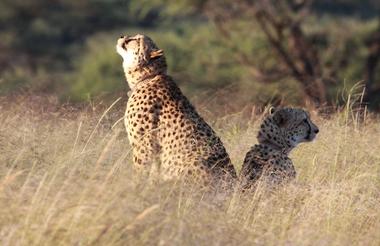

The Okonjima Private Game Reserve rests at the foot of the sandstone Omboroko Mountains amidst Acacia thornveld in a Malaria-free area. It is halfway between Namibia’s capital city, Windhoek, and the Etosha National Park – only a two-and-a-half-hour drive.
Okonjima Nature Reserve
This Reserve is equally famed for frequent cheetah and leopard sightings on its safaris, as well as The AfriCat Foundation. Since being founded in 1991, AfriCat’s mission has been to make significant contributions to conservation, while trying to ensure the survival of Namibia’s predators in their natural habitat. It undertakes research, community support, and environmental education projects, as well as conservation work to rehabilitate carnivores such as cheetah and hyaena.
- Fully inclusive: Bed, all Meals, Fees, and Activities
- After your last breakfast, rad transfer to Okonjima Airstrip
- Scheduled shared charter flight to Windhoek Eros Airport [ERS], Windhoek
- Road transfer to Hosea Kutako International Airport [WDH], Windhoek
Depending on the schedule of your outbound flight, we can book for you a day room in Windhoek, to relax before your flight






